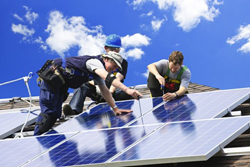 By Richard Schlesinger | EnergyBiz
By Richard Schlesinger | EnergyBiz
There have been two ways to harness the sun to generate electricity: build a large, single array that might produce as much as 50 megawatts to feed directly into the grid in much the way the output of a traditional power plant would, or, install small rooftop units and use net metering to offset a homeowner’s electric bill by the amount the rooftop solar panels contribute. From the utility’s perspective, the rooftop option is really a net loss. And with a payback period of perhaps six or seven years, although that’s much shorter than the 12 to 15 years for rooftop solar installed just a few years ago, it remains a rather low-return, long-term investment for the homeowner.
But there may be a third option that, at least theoretically, could be attractive to both utilities and power customers: solar aggregation, treating several hundred or more individual rooftop installations as a single, virtual distributed generation power plant. It’s an idea being actively pursued by some of the larger PV manufacturers and being considered by a small number of utilities. In many ways, aggregation looks attractive. Depending on how the business model is developed, it could offset the cost of installation, help meet increasingly demanding state requirements for renewable power and help utilities take advantage of grid capacity in locations where demand is increasing. At least, that’s how the theory goes.











